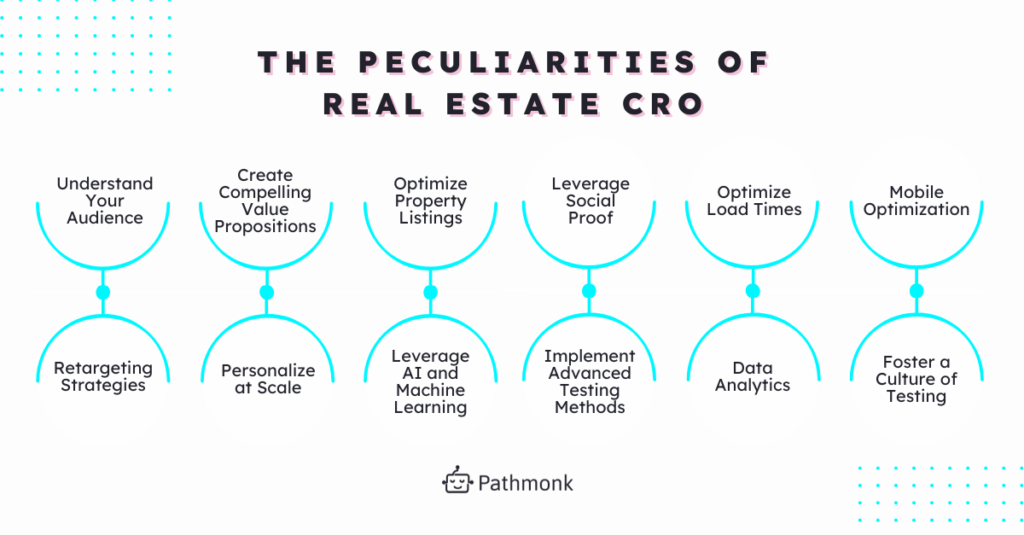
The real estate industry— a world where every home is a castle and every potential buyer is on a quest for their perfect fit. In such a fiercely competitive market, having a visually appealing website alone isn’t enough to convert curious visitors into committed clients. That’s where Conversion Rate Optimization (CRO) comes into play.
According to the National Association of Realtors (NAR), a staggering 44% of home buyers start their property search online. That’s nearly half of your potential market making their first impression of your business based on your online presence. And here’s a fun fact: homes with high-quality photos sell 32% faster than those with low-quality visuals, according to Redfin. So, not only do you need to attract these online visitors, but you also need to engage them effectively to close the deal.
But simply driving traffic to your site won’t cut it. You need to create an experience that’s seamless, engaging, and, most importantly, tailored to the unique needs of your audience. So get ready to explore how you can turn your real estate website into a conversion machine!
Table of Contents
The Peculiarities of Real Estate CRO
The real estate market has its own set of challenges and nuances that make CRO a bit more complex. It’s not just about getting clicks; it’s about building trust, showcasing value, and making the user experience as seamless as possible.
Understanding Your Audience
Knowing your audience is crucial, but in real estate, this goes beyond basic demographics. You need to understand the motivations behind a buyer’s search. Are they looking for a family home, an investment property, or a vacation getaway? Each of these categories has different pain points and desires. Use different analytics tools to segment your audience based on their search behavior and interaction with your site.
For example, first-time homebuyers might be more concerned about affordability and neighborhood safety, while investors might prioritize ROI and market trends. Families might look for properties close to good schools and parks, while retirees could be interested in smaller, easy-to-maintain homes.
Creating Compelling Value Propositions
In real estate, your value proposition needs to speak to both the emotional and practical needs of your potential clients. For example, if you’re targeting first-time homebuyers, emphasize ease of the buying process and support services. For investors, highlight ROI, property management services, and market trends. Use A/B and other testing techniques to see which value propositions resonate most with your different audience segments.
For instance, Redfin highlights its technology-driven approach and lower commission rates compared to traditional agents. Zillow, on the other hand, emphasizes its comprehensive database and easy-to-use platform. These tailored value propositions help these companies attract different segments of the real estate market.
Optimizing Property Listings
Property listings are the core of any real estate website. But simply posting photos and descriptions isn’t enough. Here’s how you can optimize:
- High-quality visuals: Invest in professional photography and virtual tours.
- Detailed descriptions: Go beyond basic descriptions. Highlight unique selling points, neighborhood amenities, and recent renovations. Make sure every detail is tailored to what your target audience values most.
- Interactive maps: Integrate interactive maps that show the property’s proximity to schools, parks, and public transport. This adds value and helps potential buyers visualize their life in the new home.
Leveraging Social Proof
In real estate, social proof can be a game-changer. Here’s how to leverage it effectively:
- Client testimonials: Include detailed testimonials from satisfied clients, preferably with photos and video testimonials.
- Case studies: Showcase successful sales stories with before-and-after scenarios, highlighting the challenges and how your agency overcame them.
- Ratings and reviews: Encourage satisfied clients to leave reviews on platforms like Zillow, Realtor.com, and Google. Display these ratings prominently on your site to build trust.
Speed Matters: Optimizing Load Times
A slow website can be a deal-breaker, especially when potential buyers are browsing multiple listings. A report by Search Engine Journal revealed that nearly 70% of consumers say a website’s loading time affects their willingness to make a purchase. Apply the same principle to real estate. Compress images, use lazy loading for photos, and optimize your site’s code to ensure fast load times.
Mobile Optimization
With a significant number of users searching for properties on their mobile devices, a mobile-optimized site is non-negotiable. Use responsive design to ensure your site looks and functions well on all devices. Simplify navigation and make sure all interactive elements are easily tappable.
Retargeting Strategies
Retargeting is especially effective in real estate, where the buying cycle can be long. Implement these strategies:
- Dynamic retargeting ads: Show ads featuring properties that users have previously viewed. This keeps your listings top-of-mind.
- Email retargeting: Send personalized emails to users who have signed up but haven’t converted. Include properties similar to those they’ve shown interest in.
- Content retargeting: Offer valuable content such as market reports, home-buying guides, or neighborhood insights to re-engage potential buyers.
2.5x better ad results with cookieless retargeting
Create high-converting retargeting ads based on your users' real-time intent.

Personalization at Scale
Personalization can significantly enhance user experience in real estate. Use data from previous interactions to personalize the content and offers:
- Personalized property recommendations: Use algorithms to recommend properties based on a user’s search history and preferences.
- Tailored email campaigns: Segment your email list based on user behavior and send targeted content. For example, send updates about new listings to active searchers and market trends to investors.
- Real time website personalization: present personalized content on your website, based on the intention and behavior of each visitor with Pathmonk.
Leveraging AI and Machine Learning
AI and machine learning can transform your CRO strategy. Tools like Zillow’s Zestimate use machine learning to predict property values, enhancing user trust and engagement. Implement AI-driven chatbots to provide instant assistance and personalized property suggestions. Machine learning algorithms can also analyze user behavior to predict and recommend properties more accurately.
Implementing Advanced Testing Methods
In real estate, multivariate testing can provide deep insights. For example, test different combinations of listing layouts, CTAs, and visual elements to see which combination yields the highest conversions. Personalization testing can help you understand the effectiveness of different tailored experiences for various audience segments.
Data Analytics
Data analytics is vital for refining your CRO strategy. Use tools like Pathmonk to track user interactions and identify drop-off points. Analyze which listings get the most views and which pages have the highest bounce rates. Use this data to make informed adjustments.
Fostering a Culture of Experimentation
Encourage your team to continually test and refine strategies. Celebrate successful experiments and learn from those that fail. Create a structured process for testing new ideas, using project management tools to track and measure outcomes.

Real-Life Example of Successful CRO in Real Estate: Zala Springs
Zala Springs Golf Resort, a luxury real estate development in Hungary, struggled to convert a significant portion of its website traffic into qualified leads, which was critical for its high-end real estate offerings. Despite offering world-class amenities and targeting affluent customers, the resort needed an effective way to improve its conversion rates and overall sales pipeline efficiency.
To address this, Zala Springs implemented Pathmonk, an AI-driven solution designed to enhance user experience by personalizing interactions based on visitor behavior. Pathmonk seamlessly integrated with Zala Springs’ existing website, automatically adapting to the resort’s aesthetic and content without requiring major redesigns or adjustments. The tool focuses on guiding potential customers through the buyer journey, addressing their specific needs and reducing friction that typically hinders conversions.
Within three months of implementing Pathmonk, Zala Springs experienced a significant transformation in its lead generation process. The resort saw a remarkable 90% increase in real estate inquiries, demonstrating the effectiveness of Pathmonk in converting casual website visitors into serious buyers. This surge in leads was not only quantitative but also qualitative, with the resort noticing an improvement in the quality of the leads generated, leading to more productive interactions and a stronger sales pipeline.

The success of Zala Springs with Pathmonk highlights the importance of personalized digital experiences in the competitive real estate market. By leveraging AI to tailor content and interactions to individual visitors, Zala Springs was able to significantly enhance its online engagement and drive meaningful growth in its customer base. This case underscores the potential for AI-driven tools like Pathmonk to revolutionize how businesses approach lead generation and conversion optimization.
Advanced CRO Techniques for Real Estate
Now that we’ve seen some examples, let’s dive into more advanced CRO techniques that can take your real estate marketing to the next level.
AI-Powered Lead Generation for Real Estate Websites
Especially considering the high ticket each customer represents in real estate, it is mandatory for your website to offer outstanding experiences and maximize the chances of conversion. Pathmonk’s AI-powered personalization guarantees that every user will see what they need to see to significantly decrease their time to conversion. All that with no cookies and no extra work for your marketing team!
This personalization not only takes into consideration their behavior on your website, but rather a pack of data from other sources that will give you valuable information on what they are looking for. Take an interactive demo with Pathmonk today!
Predictive Analytics
Predictive analytics uses historical data to predict future behavior. In real estate, this can help you identify which users are most likely to convert and target them with personalized offers. For instance, if data shows that users who view a property three times are more likely to schedule a viewing, you can send a personalized email to those users encouraging them to book a tour.
Geo-Targeting
Geo-targeting allows you to deliver content based on a user’s geographic location. This is particularly useful in real estate, where location is a key factor in decision-making. For example, you can show users listings that are within a certain radius of their current location or highlight properties in popular neighborhoods.
Continuous Improvement: The Key to Successful CRO
CRO is an ongoing process of testing, analyzing, and optimizing. It’s not something you can set and forget. To achieve maximum impact, you need to foster a culture of continuous improvement.
- Regularly review your data: Make it a habit to review your data regularly. Look for trends and patterns that can provide insights into user behavior and areas for improvement.
- Test new ideas: Encourage your team to test new ideas and strategies. Use A/B testing and multivariate testing to see what works best.
- Learn from failures: Not every test will be a success, and that’s okay. Learn from your failures and use those insights to refine your strategy.
- Stay up-to-date with trends: The digital landscape is constantly evolving, and so should your CRO strategy. Stay up-to-date with the latest trends and technologies in real estate marketing.
Increase +180%
leads
demos
sales
bookings
from your website with AI
Get more conversions from your existing website traffic delivering personalized experiences.

In the end, the goal of CRO in real estate is not just to increase traffic but to create a seamless, engaging, and trustworthy experience that turns curious browsers into committed buyers. It’s about building relationships, showcasing value, and continuously refining your strategy. So, let’s roll up our sleeves and get to work—there’s a world of potential homeowners out there waiting to be converted.





